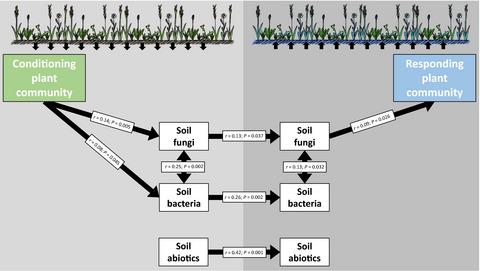当前位置:
X-MOL 学术
›
Ecol. Lett.
›
论文详情
Our official English website, www.x-mol.net, welcomes your
feedback! (Note: you will need to create a separate account there.)
Plant community composition steers grassland vegetation via soil legacy effects.
Ecology Letters ( IF 7.6 ) Pub Date : 2020-04-07 , DOI: 10.1111/ele.13497 Robin Heinen 1, 2 , S Emilia Hannula 1 , Jonathan R De Long 1 , Martine Huberty 1, 2 , Renske Jongen 1 , Anna Kielak 1 , Katja Steinauer 1 , Feng Zhu 1, 3 , T Martijn Bezemer 1, 2
Ecology Letters ( IF 7.6 ) Pub Date : 2020-04-07 , DOI: 10.1111/ele.13497 Robin Heinen 1, 2 , S Emilia Hannula 1 , Jonathan R De Long 1 , Martine Huberty 1, 2 , Renske Jongen 1 , Anna Kielak 1 , Katja Steinauer 1 , Feng Zhu 1, 3 , T Martijn Bezemer 1, 2
Affiliation

|
Soil legacy effects are commonly highlighted as drivers of plant community dynamics and species co-existence. However, experimental evidence for soil legacy effects of conditioning plant communities on responding plant communities under natural conditions is lacking. We conditioned 192 grassland plots using six different plant communities with different ratios of grasses and forbs and for different durations. Soil microbial legacies were evident for soil fungi, but not for soil bacteria, while soil abiotic parameters did not significantly change in response to conditioning. The soil legacies affected the composition of the succeeding vegetation. Plant communities with different ratios of grasses and forbs left soil legacies that negatively affected succeeding plants of the same functional type. We conclude that fungal-mediated soil legacy effects play a significant role in vegetation assembly of natural plant communities.
中文翻译:

植物群落组成通过土壤遗留效应引导草原植被。
土壤遗留效应通常被强调为植物群落动态和物种共存的驱动力。然而,缺乏在自然条件下调理植物群落对响应植物群落的土壤遗留效应的实验证据。我们使用六个不同的植物和草和草的比例和持续时间,使用六个不同的植物群落对192个草地进行了处理。土壤真菌对土壤真菌而言是显而易见的,但对土壤细菌而言则不明显,而土壤非生物参数并未随条件的变化而显着变化。土壤遗产影响了后续植被的组成。具有不同草和草比例的植物群落留下的土壤遗留物对相同功能类型的后继植物产生了负面影响。
更新日期:2020-04-07
中文翻译:

植物群落组成通过土壤遗留效应引导草原植被。
土壤遗留效应通常被强调为植物群落动态和物种共存的驱动力。然而,缺乏在自然条件下调理植物群落对响应植物群落的土壤遗留效应的实验证据。我们使用六个不同的植物和草和草的比例和持续时间,使用六个不同的植物群落对192个草地进行了处理。土壤真菌对土壤真菌而言是显而易见的,但对土壤细菌而言则不明显,而土壤非生物参数并未随条件的变化而显着变化。土壤遗产影响了后续植被的组成。具有不同草和草比例的植物群落留下的土壤遗留物对相同功能类型的后继植物产生了负面影响。











































 京公网安备 11010802027423号
京公网安备 11010802027423号